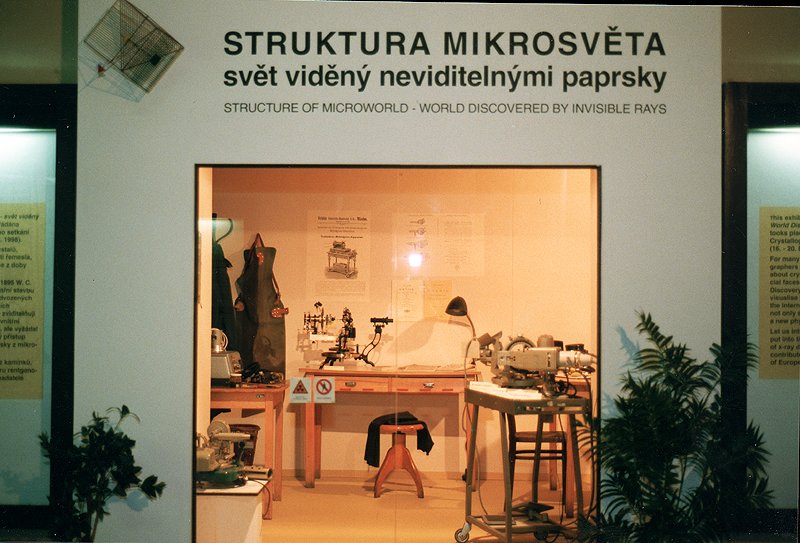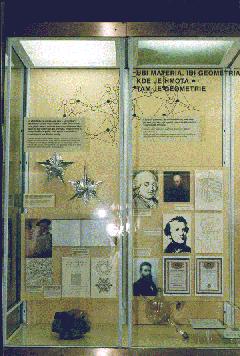

The exhibition was presented by the Czech and Slovak Crystallographic Association, the National museum and the Archives AS CR and with the support of grant PG 98136 of the Ministry of Education CR at the occasion of the 18th ECM .
The aim of the exhibition was to introduce the history of crystallography and the use of X-ray diffraction methods in understandable way to the general public and mainly to the young people.
The very short history of crystallography was presented on the personalities of Aggricola, J. Kepler, J.B. Romé de l´Isle, R.J. Haüy and A. Bravais. For many visitors it was surprising to find out that the liquid crystals were discovered in Prague in 1888 by Friedrich Reinitzer (1857-1927) - professor at the German University of Prague. He was born in Prague in a German family. His article about the mesomorphic phases of cholesterolacetate and cholesterolbenzoate was published in S.B.Keiserl. Acad. Wiss.Wien 92 (1888) 167. He collaborated with O. Lehmann from Aachen. H. Zoecher, professor at the German Technical University in Prague brought back the research of liquid crystals in 1931-1939.
W.C. Röntgen, M.von Laue, W.L. Bragg - famous personalities of x-ray diffraction and their groundwork were mentioned too.
 |
The beginning of x-ray diffraction methods in our country goes back to the period after the World War I. It was mainly Prof.V. Dolejšek and his students at the Czech University of Prague as well as Prof.A. Šimek at the Faculty of Natural Sciences in Brno, who launched systematic studies of x-rays. In 1934 the Physical Research department of the Škoda’s factory was established with the effort to realize the interconnection of basic and applied research.
The scientific contacts with the specialists from abroad (i.e. M. Siegbahn, M. de Broglie, W.L. Bragg ) and stays our researches in foreign Universities played an important role in the development of this branch of science and personal friendships.
The close cooperation of physical chemist Jan Böhm (1895-1952) with K.Weissenberg lead to the construction of the Weissenberg – Böhm goniometer for crystal structure determination.
Also research of Prof.F. Ulrich and Dr . P. Skulari and the first books on x-rays in the Czech language were reminded.
Prof. Adéla Kochanovská - Němejcová (1907-1985) represents the very famous woman of the Czech x-ray diffraction society. Not only because of her work, books and university textbook, but also for her organization of Discussions on problems in x-ray diffraction (1th in 1954 and 244th in 1998).
First doctoral thesis presented at the Czech University in Prague concerning x-rays were submitted in 1917 (R. Šimůnek: The interference of x-rays) and in 1920 (A.D. Kašparová: Crystallographic investigation of some synthetic compounds).
About 200 persons from Czechoslovakia, England, France and USA took part at 1th International conference (28.11.-1.12.1945) dealt with the use of x-rays in metallurgy. The report (Nature, March 30,1946) amounts to 40 x-ray specialists from Czechoslovakia at that time.
The easy handle x-ray generator Mikrometa and other accessories made by Chirana factory were not forgotten. Dr.F. Khol (1915-1990) was mentioned, as the initiator of Chirana x-ray tube production and the author of device for the measurement of internal stresses.
A short history of the Czech and Slovak Crystallographic Association and its main activities in present time were given with the sceptre of Association.
To make a short break from a serious science, the crystals as the source of inspiration of architects were presented on the photos of cubism architecture in Prague. The expressive symmetry, the game with combinations of faces and angles and beautiful deformations can be observed on the buildings constructed from 1910 to 1925 by architects i.e. J. Gočár, J. Chochol, E. Králíček, P. Janák.
A fairy tale about x-ray diffraction and x-ray diffraction phase analysis explained the basic knowledge needed for other part of exhibition. Examples of x-ray diffraction methods in medicine, biochemistry and mineralogy were employed to illustrate the various applications of x-ray methods in contemporary life.
The practical use of x-ray diffraction started with the phase analysis of urinary calculi, gallstones composition determination and drugs identifications. The research of new drugs like cyclosporin A, ergot alkaloids and development of anti-AIDS drugs followed. Mineralogical part attracted visitors by beautiful photos of Meteor Crater and historical two-circle reflecting goniometer made in 19th century. Young people were attracted by the computer controlled, simulated diffraction experiment. Precession diffaction method, Laue method, texture and stress measurements showed examples how the results obtained from x-ray diffraction experiments are important for crystal examinations and for metallurgy.
The old x-ray laboratory, interactive computer program of crystal structures and video-films made the inseparable part of exhibition.
It is a great pity that colleagues from Slovakia did not find the time for active participation in the exhibition.
Following are some comments of visitors written into the visitors‘ books.:
Bylo to super, ale mě do toho nic není. M.K. (The exhibition was excellent, but I
am not interested in it.)
Bolo to velmi zaujímavé susedia. Čau Pavol Záhumenický (It was very interesting,
neighbours.)
A very nice exhibition. All.
Too often the sience is presented without the history.We can learn also more then science
from scientists. David Rickelts UK.
I liked all those lovely, gorgeous scientific knick-knack, love. Patsy Store.
Congratulations to the authors for this interesting and very impressive work. P.Klimanek
Congratulation to the nice and very didactical exhibition of the history of crystallography followed by x-ray crystallography. I do like to remember the 40 years spent with „časky“ instruments. A.Kalmán
I found the exhibits fascinating and very informative-very well done. Mardi Doherty, Australia
Vůbec se mi to nelíbí. Janáková, Pelhřimov (I don‘t like it at all.)
Pěkná blbost, velmi nezáživné, jako celá fyzika. DDD (Very stupid, like the whole physics.)
Kdybych se byl býval lépe učil fyziku snad bych i lépe rozuměl, ale i tak mě uchvátily přístroje a taky počítačové struktury. Tomáš B.Novák (If I learned physics better, I would understand it. I was fascinated by devices and crystal structures on computer.)
Bylo to tu pěkné na to že je mi 9let tak tomu rozumím. Martina Morávková, Jičín (It was nice here, I am 9 years old and everything is clear to me )
Our thanks to all who participated on the exhibition preparation and instalation ! To M. Čepera (texture), J. Hybler (Laue method), A. Jegorov (drugs research), I. Kraus (history, stress), D. Krausová (medicine), B. Kratochvíl (drugs research), J. Loub (fig. principle of diffraction), J. Marek (videofilms), P. Ondruš and R. Skála (mineralogy, x-ray diffraction experiment, interactive computer program), J. Peterková- Dušková (anti-AIDS drug), M. Rieder (precession camera), E. Těšínská (history). Exhibition design: J. Řehák